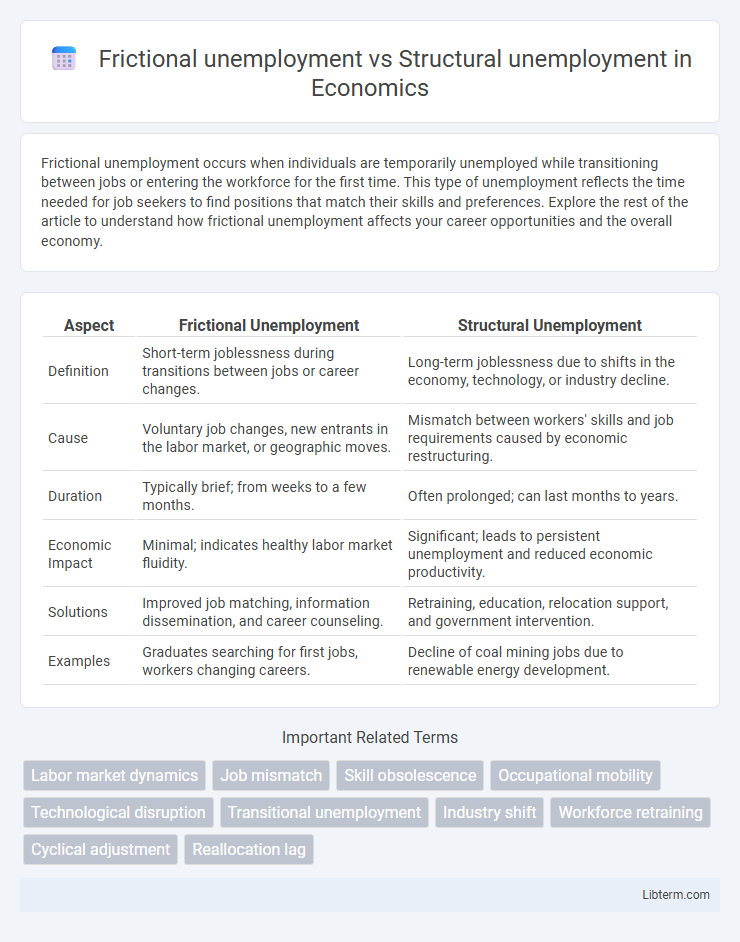Frictional unemployment occurs when individuals are temporarily unemployed while transitioning between jobs or entering the workforce for the first time. This type of unemployment reflects the time needed for job seekers to find positions that match their skills and preferences. Explore the rest of the article to understand how frictional unemployment affects your career opportunities and the overall economy.
Table of Comparison
| Aspect | Frictional Unemployment | Structural Unemployment |
|---|---|---|
| Definition | Short-term joblessness during transitions between jobs or career changes. | Long-term joblessness due to shifts in the economy, technology, or industry decline. |
| Cause | Voluntary job changes, new entrants in the labor market, or geographic moves. | Mismatch between workers' skills and job requirements caused by economic restructuring. |
| Duration | Typically brief; from weeks to a few months. | Often prolonged; can last months to years. |
| Economic Impact | Minimal; indicates healthy labor market fluidity. | Significant; leads to persistent unemployment and reduced economic productivity. |
| Solutions | Improved job matching, information dissemination, and career counseling. | Retraining, education, relocation support, and government intervention. |
| Examples | Graduates searching for first jobs, workers changing careers. | Decline of coal mining jobs due to renewable energy development. |
Introduction to Unemployment Types
Frictional unemployment occurs when workers are temporarily between jobs due to voluntary transitions or entering the labor market for the first time. Structural unemployment arises from long-term shifts in the economy, such as technological changes or mismatches between workers' skills and job requirements. Understanding these distinct types is crucial for developing targeted employment policies and workforce training programs.
Defining Frictional Unemployment
Frictional unemployment refers to the short-term joblessness experienced by individuals who are temporarily between jobs or searching for their first positions, reflecting normal labor market turnover. It arises from workers voluntarily changing jobs or entering the workforce, where matching job seekers with suitable employers takes time. Unlike structural unemployment, which results from mismatches between skills and job requirements due to technological changes or industry shifts, frictional unemployment is natural and often indicates a dynamic economy.
Understanding Structural Unemployment
Structural unemployment arises from fundamental shifts in the economy such as technological advancements or changes in consumer demand that render certain skills obsolete. It often results in a mismatch between workers' abilities and available jobs, requiring retraining or relocation to new industries. Unlike frictional unemployment, which is short-term and linked to job transitions, structural unemployment tends to be more persistent and challenging to address.
Key Differences Between Frictional and Structural Unemployment
Frictional unemployment occurs when workers are temporarily between jobs or searching for new ones that better match their skills, reflecting the normal turnover in the labor market. Structural unemployment arises from a mismatch between workers' skills and the demands of the current job market, often caused by technological changes or shifts in the economy. Frictional unemployment is usually short-term and voluntary, while structural unemployment tends to be long-term and requires retraining or relocation to resolve.
Causes of Frictional Unemployment
Frictional unemployment arises primarily from the time period individuals spend transitioning between jobs, often caused by voluntary career changes, job search duration, or geographic relocation. It is influenced by imperfect information about available job opportunities and workers' preferences for better positions or improved working conditions. This type of unemployment is typically short-term and considered a natural part of a dynamic labor market.
Causes of Structural Unemployment
Structural unemployment arises primarily from long-term shifts in the economy, such as technological advancements, globalization, and changes in consumer preferences that render certain skills obsolete. Unlike frictional unemployment, which results from short-term job transitions, structural unemployment is caused by a mismatch between workers' skills and the demands of the labor market. Key factors include industry decline, automation replacing manual jobs, and geographic immobility limiting workers' ability to relocate to regions with available employment opportunities.
Economic Impact of Frictional Unemployment
Frictional unemployment represents the short-term joblessness individuals face while transitioning between jobs, which typically leads to minimal economic disruption as it reflects a dynamic labor market. This form of unemployment allows better job matching, increasing overall productivity and economic efficiency despite temporary income loss for workers. In contrast, structural unemployment indicates a deeper, longer-lasting mismatch between skills and job requirements, causing more significant negative impacts on economic growth and workforce stability.
Economic Impact of Structural Unemployment
Structural unemployment causes more profound economic challenges than frictional unemployment because it reflects a mismatch between workers' skills and job requirements, often leading to long-term joblessness and decreased labor force participation. Persistent structural unemployment can reduce overall economic growth by lowering productivity and consumer spending, increasing reliance on social welfare programs. This type of unemployment demands targeted policy interventions such as retraining programs and educational reforms to realign workforce capabilities with evolving market demands.
Policy Solutions for Each Unemployment Type
Frictional unemployment can be reduced through improved job matching services such as enhanced career counseling, efficient online job portals, and streamlined application processes that shorten the job search period. Structural unemployment requires long-term policy solutions including retraining programs tailored to emerging industries, investment in education to align workforce skills with market demands, and regional development initiatives to address geographic job mismatches. Governments often implement active labor market policies like subsidies for vocational training and partnerships with private sectors to facilitate smoother transitions for displaced workers.
Conclusion: Addressing Unemployment Challenges
Addressing unemployment challenges requires targeted strategies recognizing that frictional unemployment stems from normal labor market transitions, while structural unemployment results from mismatches between workers' skills and job requirements. Policymakers must enhance job matching services and provide retraining programs to reduce frictional unemployment duration and equip displaced workers with skills aligned to evolving industries. Effective mitigation of structural unemployment depends on long-term investments in education, workforce development, and regional economic revitalization to align labor supply with dynamic market demands.
Frictional unemployment Infographic

 libterm.com
libterm.com